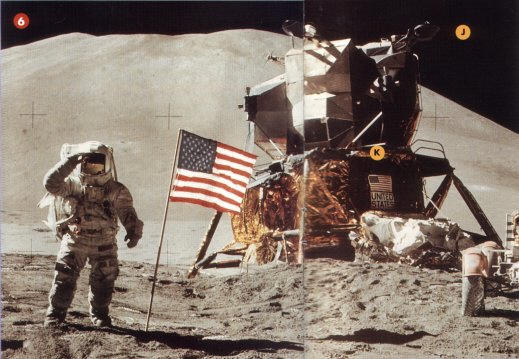
According to DARK SIDE OF THE MOON, the most important film of its kind since Oliver Stone's JFK - or since Rob Reiner's This is Spinal Tap, at any rate - images of Neil Armstrong's walk on the moon on July 20, 1969 were shown to the world through the lens of master film-maker Stanley Kubrick and were staged on the same Borehamwood, U.K., soundstage where Kubrick made his landmark film, 2001: A Space Odyssey.
Thursday, July 13, 2006: The original high-quality video tapes of Apollo 11, which were apparently sent by NASA to the National Archives and then were returned to the Goddard Space Flight Center, have gone missing (see the pdf by John M. Sarkissian). The quality of the video broadcast to the world on television was of much, much lower quality than the video originally received – or manufactured! - by NASA. Obviously, if you were going to fake the moon landing, you might have a motive to ‘lose’ the high-quality tapes, where artifacts of faking could be seen. This was by far the biggest moment in the American space program. You’d think they would care about hanging on to the evidence.
Motives
Several motives have been suggested for the U.S. government to fake the moon landings - some of the recurrent elements are:- Distraction - The U.S. government benefited from a popular distraction to take attention away from the Vietnam war. Lunar activities did abruptly stop, with planned missions cancelled, around the same time that the US ceased its involvement in the Vietnam War.
- Cold War Prestige - The U.S. government considered it vital that the U.S. win the space race with the USSR. Going to the Moon, if it was possible, would have been risky and expensive. It would have been much easier to fake the landing, thereby ensuring success.
- Money - NASA raised approximately 30 billion dollars pretending to go to the moon. This could have been used to pay off a large number of people, providing significant motivation for complicity. In variations of this theory, the space industry is characterized as a political economy, much like the military industrial complex, creating fertile ground for its own survival.
- Risk - The available technology at the time was such that there was a good chance that the landing might fail if genuinely attempted.
For Complete Info visit: http://www.apfn.org/apfn/moon.htm
No comments:
Post a Comment